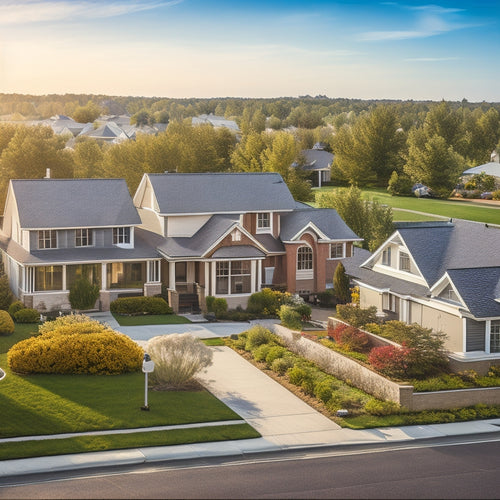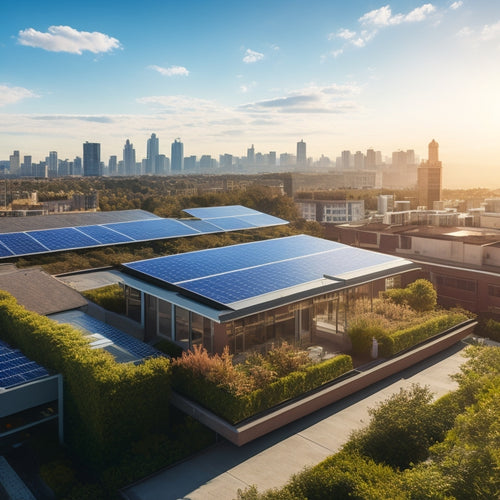
Sizing Guide for Large Homes: Panel System Needs
Share
When sizing a panel system for your large home, you'll need to take into account multiple factors. Start by calculating your energy requirements, factoring in home size, insulation, window orientation, and climate. Next, determine your roof size and shape, taking note of obtrusions and architectural style. Shading and obstructions, such as tree canopies and skylights, also impact system performance. Then, select the right panel type based on energy efficiency, durability, and aesthetics. Finally, properly size your inverter and battery for best system operation. By doing so, you'll discover the key to a tailored panel system that meets your unique needs, and understand the specifics of each component's role in the process.
Key Takeaways
• Determine roof size and shape to ensure accurate panel system sizing and configuration.
• Assess shading and obstructions to optimize panel performance and efficiency.
• Select the right panel type based on energy efficiency, durability, and aesthetics for large homes.
• Properly size inverters and batteries to reduce energy losses and enhance production.
• Consider load calculations and energy audit results to guide ideal panel system size and configuration for large homes.
Calculating Energy Requirements
To ascertain the ideal heating, ventilation, and air conditioning (HVAC) system for your large home, you'll need to calculate its total energy requirements, which depend on various factors, including the home's size, insulation, window orientation, and local climate. This calculation is vital in ensuring your HVAC system is neither oversized nor undersized, as both scenarios can lead to energy waste and increased costs.
Conducting an energy audit is an essential step in this process. An energy audit helps identify areas of heat loss and gain, allowing you to pinpoint opportunities for improvement. You'll need to gather data on your home's construction, including the type and R-value of insulation, window sizes and orientations, and the number and type of doors. You'll also need to take into account local climate data, including temperature and humidity levels.
Next, you'll need to perform load calculations to determine the total energy requirements of your home. This involves calculating the heating and cooling loads for each room, taking into account factors such as occupancy, lighting, and equipment usage. By combining the results of your energy audit and load calculations, you'll be able to determine the ideal HVAC system size and configuration for your large home.
Determining Roof Size and Shape
With your home's energy requirements calculated, you can now focus on determining the roof size and shape, a critical factor in selecting an HVAC system that can efficiently heat and cool your large home. The roof's size and shape greatly impact the system's performance, as they influence heat gain and loss.
To accurately determine your roof's size, measure its length, width, and any obtrusions, such as skylights or vents. Note the roof's orientation, as a south-facing roof receives more direct sunlight than a north-facing one. This information will help you choose the right panel system.
Your home's architectural style also plays a role in determining the roof's size and shape. For instance, a modern, flat-roofed design will have different requirements than a traditional, gabled roof. Consider the roof's complexity, including the number of valleys, hips, and ridges, as these features affect the system's installation and performance.
Assessing Shading and Obstructions
Shading and obstructions around your large home can greatly impact the performance of your HVAC system. It's crucial you identify and address any issues before selecting a panel system. Factors like tree canopy, window orientation, and other obstructions can greatly affect the system's efficiency and overall performance.
To guarantee peak performance, assess the following potential shading and obstruction issues:
-
Tree Canopy: Identify trees with canopies that may cast shade on your roof, especially during peak sun hours. Consider pruning or removing trees that obstruct direct sunlight.
-
Window Orientation: Determine the orientation of your windows and how they may impact solar radiation. Windows with southern exposure may receive more direct sunlight, while those with northern exposure may receive less.
-
Roof Obstructions: Take note of any roof features, such as skylights, vents, or chimneys, that may cast shade or obstruct airflow.
Selecting the Right Panel Type
When selecting the appropriate panel type for your large home's HVAC system, it's important to take into account factors such as energy efficiency, durability, and aesthetics. You want a panel that will provide peak performance while also complementing your home's design.
In terms of panel efficiency, look for options with high wattage ratings and low temperature coefficients. This guarantees that your system will generate ample power even in hot or cold conditions. Additionally, consider the frame materials used in the panel's construction. Aluminum frames are lightweight and corrosion-resistant, while anodized frames offer enhanced durability.
When evaluating panel types, you'll encounter monocrystalline, polycrystalline, and thin-film options. Monocrystalline panels boast high efficiency rates, but are often more expensive. Polycrystalline panels offer a balance of efficiency and affordability, while thin-film panels provide a cost-effective solution.
Sizing the Inverter and Battery
You'll need to make sure your inverter and battery are properly sized to handle the energy output of your newly selected solar panels. This is essential to guarantee that your system operates efficiently and effectively.
To determine the required inverter capacity, consider the following factors:
- Maximum Power Point Tracking (MPPT): Ensure the inverter's MPPT range aligns with the solar panel's maximum power voltage.
- System Voltage: The inverter's voltage capacity should match the system voltage of your solar panel array.
- System Size: The inverter's capacity should be compatible with the total wattage of your solar panel system.
A properly sized inverter will optimize energy production and reduce energy losses.
Additionally, consider the battery lifespan and its compatibility with the inverter's charging and discharging capabilities. This will ensure a seamless energy storage and release process, providing you with a reliable and efficient power supply.
Frequently Asked Questions
Can Solar Panels Be Installed on a Metal or Clay Tile Roof?
When you install solar panels on a metal or clay tile roof, make sure the roof's durability can support the added weight, and consider tile fragmentation risks, as broken tiles can compromise the roof's integrity and your system's performance.
How Often Should Solar Panels Be Cleaned for Optimal Performance?
You should clean your solar panels every 6-12 months to prevent dust accumulation, as it can reduce energy output by up to 25% and negatively impact performance metrics like efficiency and power output.
Are There Any Government Incentives for Installing Solar Panels?
Sweet relief from skyrocketing energy bills! You'll be thrilled to know that, yes, there are government incentives for installing solar panels, including lucrative tax credits, making renewable energy a more affordable and attractive option for you.
Can I Install Solar Panels Myself, or Do I Need a Professional?
While you might consider DIY solar installation to save money, you'll risk electrical shock, roof damage, and warranty voidance; instead, hiring a professional guarantees a safe, efficient, and compliant installation, maximizing your solar power benefits.
How Long Does It Take to Recoup the Cost of a Solar Panel System?
"Don't worry, the upfront cost of solar panels won't break the bank - you'll recoup your investment in 5-7 years through reduced energy bills, with a system payback of around 10-15 years, depending on your financial breakdown."
Related Posts
-

Why Choose Solar Car Battery Charging Systems?
You're switching to a cleaner, more sustainable transportation option by choosing solar car battery charging systems,...
-

Why Invest in Residential Solar Panel Systems?
By investing in a residential solar panel system, you'll harness renewable energy, reducing your carbon footprint and...
-

What Is the Cost to Put in Solar Panels
You're likely considering solar panels for your home, and the most significant factor in your decision is the upfront...


